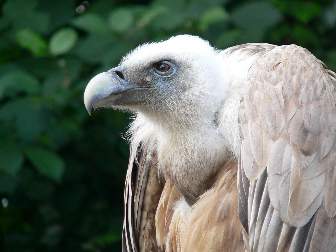|
|
The Griffon Vulture, (scientific
latin name Gyps fulvus), also known at the Great Vulture,
is found throughout a large portion of the Old World, inhabiting warmer
portions of this hemisphere, particularly around the Mediterranean areas.
The colour of the adult bird is a kind-of yellowish brown, diversified
by the black quill feathers and the ruff of white down that surrounds the
neck. The head and neck are without feathers, but are sparingly covered
with very short down of a similar character to that of the ruff.
|

Picture of the Griffon Vulture
|
It a considerably large bird, being little
short of five feet in total length, and the wingspan measuring about eight
feet. In common with other birds of its order, the Griffon Vulture
is a very long-lived bird.
One area that Griffon Vultures have made
their home is in the countries known as the Holy Land, although numbers in that country are declining
as at the year 2005, and the bird is considered to be endangered.
It is a gregarious bird - unlike the lesser though equally useful Egyptian
Vulture, the Griffon Vulture congregates together in great numbers, feeding,
flying and herding in company. Large flocks of them may be seen daily,
soaring high in the air, and sweeping their graceful way in the grand curves
which distinguish the flight of the large birds of prey. They are best
to be seen in the early morning; being in the habit of quitting their rocky
homes at daybreak, and indulging in a flight for two or three hours, after
which they mostly return to the rocks, and wait until evening, when they
take another short flight before retiring to rest.
There is something peculiarly appropriate
in employing the Vulture as an image of strength and swiftness when applied
to warriors, the bird being an invariable attendant on the battle, and
flying to the field of death with marvellous swiftness. All who had ever
witnessed a battle were familiar with the presence of the Vulture - the
scene of carnage, and the image which is employed, would be one which commended
itself at once to those for whom it was intended.
Various birds of most dissimilar aspects are sometimes known under the common title of Vulture. Some of them, especially
those which inhabit the West Indies, are slouching, sneaky in appearance
and almost mean-looking birds. But there are others which are really
grand and noble birds, which excite admiration, and one of the chief among
these is the Griffon Vulture. Scavenger though it be, it is not disgusting
in its habits, and may even be called a cleanly bird. It is intellIgent,
after its way, and is quite as susceptible of human teaching as the falcon
or the cormorant. It is not quarrelsome, and, even when feeding, does not
try to drive away its neighbour, but feeds alongside of him with perfect
amity and quietness.
|
There is, perhaps, no bird which has a
more curious set of attitudes than the Griffon Vulture, or which exhibits
so different an aspect at various times. In flight it is one of the
most magnificent birds that can be seen, and even when perched it often
retains a certain look of majesty and grandeur. Sometimes, however, especially
when basking in the sun, it assumes a series of attittides which are ahsolutely
grotesque, and convert the noble-looking bird into a positively ludicrous
object. At one moment it will sit all hunched up, its head sunk between
its shoulders, and one wing trailing behind it as if broken. At another
it will bend its legs and sit down on the ankle-joint, pushing its feet
out in front, and supporting itself by the stiff feathers of its tail.
Often it will crouch nearly flat on the ground, partly spread its wings,
and allow their tips to rest on the earth, and sometimes it will support
nearly all the weight of its body on the wings, which rest in a half doubled
state on the ground. A single bird, photographed or sketched at various
times over a single day, will show various strikingly different attitudes,
which transform the whole shape of the bird so much that it is scarcely
recognisable as the same individual.
|
|
|





